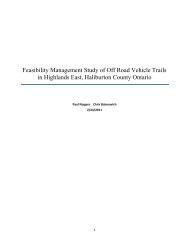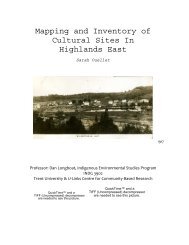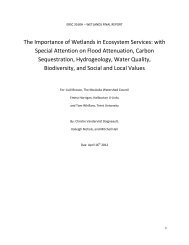Untitled - Haliburton County Community Cooperative Inc
Untitled - Haliburton County Community Cooperative Inc
Untitled - Haliburton County Community Cooperative Inc
- No tags were found...
You also want an ePaper? Increase the reach of your titles
YUMPU automatically turns print PDFs into web optimized ePapers that Google loves.
commonly ignored by anglers and thus is a poor reflection upon the economic benefits or setbacks. It isalso hard to indentify the true economic impact of dams upon trout within zone 15 as data is needed todetermine how many current or potential trout streams are dammed or planned for damming. It can bestated that current impoundment free streams supporting healthy populations of brook and browntrout could be worth an approximate value of $1,557,120 and this has the potential to increase with adecrease in dams.2.3: Boat GasThe lakes and rivers of the southern Canadian Shield provide many opportunities for motorizedrecreational boating. Yet this activity has potential degrading effects upon the waterways and has thepotential to adversely affect fish populations. Volatile organic compounds (VOCs), especially gasolinerelatedcompounds such as methyl tert-butyl ether (MTBE), are being inputted into waterways from theoperation of marine engines (Bender et al, 2003). MTBE is utilized as a fuel additive and has becomeincreasingly present within aquatic ecosystems where motorized boating occurs. The chemicalcompound directly affects fish health and studies have shown that certain species exhibit increasedlarval mortality, deformed eyes, mouthparts, and spinal cord as a result of higher concentrations(50mg/L+) (Moreels et al, 2009). Recent reports from the U.S have found MTBE concentrations of somelakes as high as 31 ug/L, though lake averages appear to hover around 0.5-2ug/L (Schmidt et al, 2003).Many studies focus on short term lethal dosages (LC96) of MTBE, and very few studies have delved intolong term effects of moderately elevated concentrations. Reports have stated that the compound isdifficult to biodegrade but does not appear to bioaccumulate at any severe levels. Lethal dosage formost fish species exceeds 350mg/L . If elevated concentrations were to occur, they would be first notedwithin primary trophic levels where select bacteria and small invertebrates experienced decreasedgrowth and mortality at concentrations ranging from 7.4-57mg/L (Werner et al, 1999). It isrecommended that the testing of highly utilized recreational lakes within the southern Canadian Shield,15







